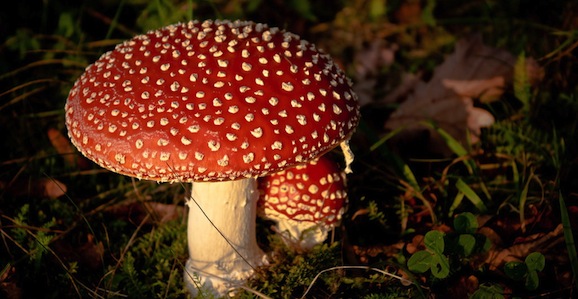Poisonous Mushrooms May Be The Key To Curing Some Diseases
This article is more than 2 years old
 Mushrooms are seriously weird. Fungi have properties unlike those of other organisms—or don’t have certain properties, as the case may be. They lack a respiratory and digestive system, and their food digestion happens outside their bodies. They like eating dead things, and eating certain mushrooms can make the adventurous but ignorant forager into a dead thing. It’s that poisonous quality that has led researchers at Michigan State University and China’s Kunming University of Science and Technology to discover that killer mushrooms might end up leading to groundbreaking medical treatments.
Mushrooms are seriously weird. Fungi have properties unlike those of other organisms—or don’t have certain properties, as the case may be. They lack a respiratory and digestive system, and their food digestion happens outside their bodies. They like eating dead things, and eating certain mushrooms can make the adventurous but ignorant forager into a dead thing. It’s that poisonous quality that has led researchers at Michigan State University and China’s Kunming University of Science and Technology to discover that killer mushrooms might end up leading to groundbreaking medical treatments.
The study, published in Chemistry and Biology, details how the researchers were able to isolate and identify a particular enzyme that causes mushrooms’ toxicity. The enzyme creates molecules called cyclic peptides, which hone in on the human liver and attack a specific part of it, poisoning the consumer. Cyclic peptides have become popular with pharmaceutical companies, which synthesize them in the lab and then use them for a whole range of treatments—they’re used as antibacterials, immune-boosting drugs, and tumor-fighting drugs. They have a high resistance to the human digestive process, so they stay intact and remain effective after ingested.
 The team discovered an enzyme called POPB, which transforms toxins, which have a linear shape, into cyclic peptides, which have molecular circles that form a denser formation. Of course, the team doesn’t intend to poison people, but they did figure out how to take apart the mushrooms and essentially disable them. The researchers compare the poisonous peptides to a missile with a nuclear warhead, with the poisonous molecules acting like the warhead. What they really wanted to figure out was how the mushroom is able to deliver the poison straight to its target, and then replicate that focused delivery with a treatment. They believe that they will be able to learn from the mushroom to deliver treatments that don’t have side effects, because rather than stuffing the entire body full of meds, which is what causes most unwanted symptoms, they will, like the mushrooms, deliver the medicine straight to its target.
The team discovered an enzyme called POPB, which transforms toxins, which have a linear shape, into cyclic peptides, which have molecular circles that form a denser formation. Of course, the team doesn’t intend to poison people, but they did figure out how to take apart the mushrooms and essentially disable them. The researchers compare the poisonous peptides to a missile with a nuclear warhead, with the poisonous molecules acting like the warhead. What they really wanted to figure out was how the mushroom is able to deliver the poison straight to its target, and then replicate that focused delivery with a treatment. They believe that they will be able to learn from the mushroom to deliver treatments that don’t have side effects, because rather than stuffing the entire body full of meds, which is what causes most unwanted symptoms, they will, like the mushrooms, deliver the medicine straight to its target.
The scientists believe that the properties of POPB are the key, and that they can replicate those properties to create a variety of molecules tailored for different diseases. “By making more variants, we can add or replace molecules that may or may not work,” says study author Jonathan Walton. The team has already created about a hundred variants, and believes that they’ll eventually have many millions. The next step involves testing those variants against specific afflictions. The screening process may take a while—the variant has to match the disease—so it remains to be seen just how effective the treatments might be. And while this is a promising start for fungi in the medical world, you probably don’t want to start popping random mushrooms












